Spatio-Temporal Estimation and Prediction for Censored/Missing Responses.
StempCens
The goal of StempCens is to estimate the parameters of spatio-temporal models with censored or missing data using the SAEM algorithm (Delyon, Lavielle, and Moulines 1999). This algorithm is a stochastic approximation of the widely used EM algorithm and is particularly useful for models in which the E-step does not have an analytical form. In addition to providing the expressions used for parameter estimation in the proposed model, the package includes the computation of the observed information matrix using the method developed by Louis (1982). To evaluate the performance of the fitted model, case-deletion diagnostics are provided (see also Cook 1977; Zhu et al. 2001). Moreover, the package computes the spatio-temporal covariance matrix and the effective range for an isotropic spatial correlation function.
A detailed description of the model can be found in Valeriano et al. (2021).
Installation
You can install the released version of StempCens from CRAN with:
install.packages("StempCens")
Functions
StempCens package provides five functions:
CovarianceM: Computes the spatio-temporal covariance matrix for balanced data.EffectiveRange: Computes the effective range for an isotropic spatial correlation function.EstStempCens: Returns the maximum likelihood estimates of the unknown parameters.PredStempCens: Performs spatio-temporal prediction in a set of new spatial locations for fixed time points.CrossStempCens: Performs cross-validation, which measure the performance of the predictive model on new test dataset.DiagStempCens: Returns measures and graphics for diagnostic analysis.
Example
This is a basic example which shows you how to solve a problem using functions EstStempCens (parameter estimation) and PredStempCens (prediction in new locations):
library(StempCens)
set.seed(403020)
# Initial parameter values
beta <- c(-1, 1.50)
phi <- 5
rho <- 0.60
tau2 <- 0.80
sigma2 <- 2
# Simulating data
coord <- matrix(round(runif(100, 0, 10),9), ncol=2)
time <- 1:5
x <- cbind(rexp(250,2), rnorm(250,2,1)) # Covariates
data <- rnStempCens(x, time, coord, beta, phi, rho, tau2,
sigma2, type.S="pow.exp", kappa=0.5,
cens="left", pcens=0.10)
# Splitting the dataset
train <- data[-c(211:220),]
test <- data[211:220,]
sum(test$ci)
#> [1] 0
# Estimation
x <- cbind(train$x1, train$x2)
est_train <- EstStempCens(train$yObs, x, train$ci, train$time, train[,1:2], train$lcl, train$ucl,
init.phi=3.5, init.rho=0.5, init.tau2=1, kappa=0.5, type.S="pow.exp",
IMatrix=TRUE, M=20, perc=0.25, MaxIter=300, pc=0.20)
#>
#> ---------------------------------------------------------------
#> Spatio-temporal models for censored/missing responses
#> ---------------------------------------------------------------
#> Estimates SE
#> β1 -1.1797 0.1877
#> β2 1.6018 0.0910
#> σ² 2.0035 1.4689
#> τ² 0.8095 0.4598
#> ϕ 4.0576 3.7428
#> ρ 0.6035 0.1143
#> The effective range is 36.414 spatial units.
#> --------------------------------------------------------------
#>
#>
#> Model selection criteria
#> ------------------------------------
#> Value
#> Loglik. -384.689
#> AIC 781.377
#> AICcorr. 781.738
#> BIC 802.261
#> ------------------------------------
#>
# Prediction
xPre <- cbind(test$x1, test$x2)
pre_teste <- PredStempCens(est_train, test[,1:2], test$time, xPre)
library(ggplot2)
Model <- rep(c("y Observed","y Predicted"),each=10)
station <- rep(rep(c("Station 1", "Station 2"),each=5), times=2)
xcoord1 <- rep(seq(1:5),4)
ycoord1 <- c(test$yObs, pre_teste$predValues)
data2 <- data.frame(Model,station,xcoord1,ycoord1)
ggplot(data=data2, aes(x=xcoord1, y=ycoord1)) + geom_line(aes(color=Model)) + theme_bw() +
facet_wrap(station~.,nrow=1) + labs(x="",y="") + theme(legend.position="bottom")

For diagnostic analysis, the input parameter IMatrix needs to be TRUE in the EstStempCens function.
diag <- DiagStempCens(est_train, type.diag="location", diag.plot = TRUE, ck=1)
References
Cook, R-Dennis. 1977. “Detection of Influential Observation in Linear Regression.” Technometrics 19 (1): 15–18. https://doi.org/10.1080/00401706.1977.10489493.
Delyon, Bernard, Marc Lavielle, and Eric Moulines. 1999. “Convergence of a Stochastic Approximation Version of the EM Algorithm.” Annals of Statistics 27 (1): 94–128. https://doi.org/10.1214/aos/1018031103.
Louis, Thomas. 1982. “Finding the Observed Information Matrix When Using the EM Algorithm.” Journal of the Royal Statistical Society: Series B (Methodological) 44 (2): 226–33. https://doi.org/10.1111/j.2517-6161.1982.tb01203.x.
Valeriano, Katherine AL, Victor H Lachos, Marcos O Prates, and Larissa A Matos. 2021. “Likelihood-Based Inference for Spatiotemporal Data with Censored and Missing Responses.” Environmetrics 32 (3): e2663. https://doi.org/10.1002/env.2663.
Zhu, Hongtu, Sik-Yum Lee, Bo-Cheng Wei, and Julie Zhou. 2001. “Case-Deletion Measures for Models with Incomplete Data.” Biometrika 88 (3): 727–37. https://doi.org/10.1093/biomet/88.3.727.